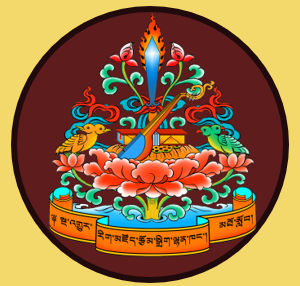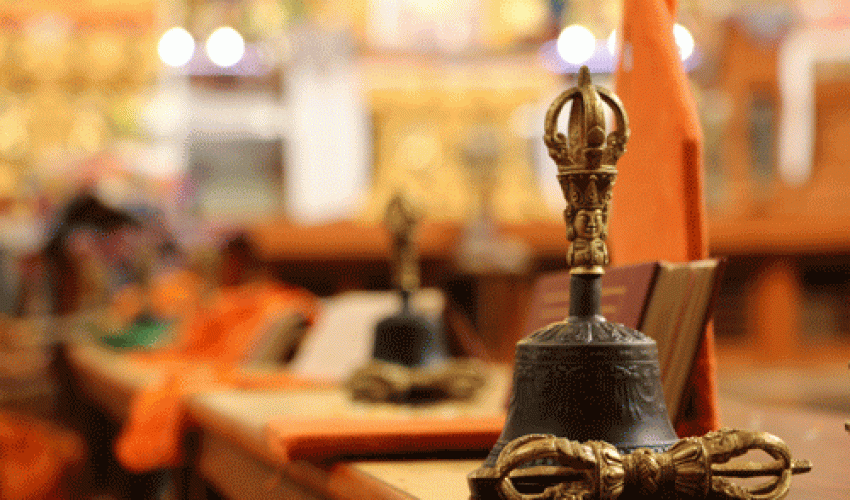VAJRA
Vajra (Tib. dorje) is defined as the non-conceptual and exalted wisdom of all the buddhas of the three times. In essence, all phenomena are empty of inherent existence, and their origin and their existence are indistinguishable. Hence, the vajra is indestructible in its nature. The literal meaning of vajra is ‘diamond’, which is uncuttable, unbreakable, solid, and stable, as well as completely unobstructed. There are also different types of symbolic, physical vajras: three-pointed, five-pointed, and nine-pointed vajras.
Generally, the three-pointed vajra is the symbol of the three kayas,1 the five-pointed vajra represents the five wisdoms,2 and the nine-pointed vajra symbolizes the ‘nine levels of the three realms’.3
The vajra is made up of different kinds of materials, like gold, silver, copper, iron, stone, crystal and sandalwood. A golden vajra supports one’s attainment of the level of vidhyadhara (awareness-holder). Silver and copper vajras help one achieve ordinary accomplishments. That of crystal makes the sense faculties more sensitive and beautifies them. A sandalwood vajra helps one conquer pisachis and yakshas. A vajra made from juniper wood is said to increase wealth and comforts. Moreover, the golden vajra is used for peaceful activities and the meteoric iron vajra for wrathful ones.
As far as their size, vajras generally range from eight to twenty-eight inches. The three-pointed vajra should be four, eight or twelve inches; the five-pointed vajra should be eight, twelve, sixteen, eighteen or twenty-two inches; and the nine-pointed vajra should be eight, eighteen or twenty-eight inches.
In terms of its structure, the left and right prongs and central joint are the three main parts of the vajra. The configuration of the prongs symbolises the four activities: round for pacifying, semi-circular for enriching, square for magnetizing and triangular for subjugating. And the upper and lower parts of the central joint should be like a string of pearls or a garland of lotus and moon seats.
Considering the three-pointed prongs, the upper three indicate the three kayas and the lower ones the ‘three doors of liberation’.4 In the case of the five-pointed prongs, the upper ones indicate the five male buddhas and the lower ones their five consorts. Similarly, in the case of the nine-pointed prongs, the four curved prongs in the cardinal directions in the upper part indicate four5 of the five buddha families,6 and the four in the intermediate directions represent their four consorts. The central prong indicates Buddha Samantabhadra and the topmost one Buddha Vairochana. The lower prongs indicate the five wisdoms and the four immeasurables,7 and the one at the peak indicates the dharmadhatu. The heads of makara symbolise the unified path and uninterrupted kindness towards beings. The moon seat is the symbol for the pacification of the suffering in samsara. The eight lotus leaves on the upper side indicate the eight bodhisattvas8 and the lower eight represent the eight offering goddesses.9 The central spherical twisted ring is the symbol for the equality of samsara and nirvana. The rosary of pearls signifies the ornament of samsara and nirvana.
BELL
In Vajrayana ritual practice, the bell symbolizes the wisdom of emptiness which is the nature of all the phenomena, beyond origination and cessation, or coming and going. Its nature is unborn. The symbolic meaning of the bell in Buddhism is that which pervades all the phenomena in the ground of emptiness and resounds with the melodies of the twelve divisions of the Buddha’s teachings. It has a hemispherical shape like a water lily. It is fashioned from either bronze, brass, copper or other metals along with a mixture of precious substances. It can be seven, eight, twelve, sixteen or eighteen inches. There are different types of bell: those with the image of kirtimukha (the face of glory), a lotus, a monkey and an ox. The bell with the image of kirtimukha helps to spread one’s activities. Likewise, that with the face of a lotus, a monkey and an ox help to accomplish powerful, wrathful and peaceful activities respectively.
The inner part of the bell has an image of a hexagram which symbolizes self-arising wisdom. The syllables ‘hung’ and ‘müm’ inside the bell are the embodiments of Buddha Akshobhya and his consort,10 or Buddha Amitabha and his consort.11 The hollow space of the bell is the residence of the indestructible body of the Buddha, the eight lotus petals encircling it symbolize his undiminishing speech, while the vase and its saucer represent the indestructible mind which is the source of all knowledge and accomplishments.
The four syllables―Hung, Tram, Hri, and Ah―which are on the four lotus petals, indicate the buddhas Akshobhya, Ratnasambhava, Amitabha and Amoghasiddhi. The four syllables―Lam, Mam, Pam, and Tam―on the four lotus petals indicate the four consorts of the buddhas: Buddhalochana, Mamaki, Pandaravasini and Samayatara. On the handle of the bell, there can be the face of Buddha Vairochana, who is the centre of mandala, or a face signifying the (mother) transcendental wisdom. There is a lotus on the handle which symbolises the quality of being undefiled by samsaric defects. The image of a moon on it symbolizes development of the enlightened mind. The vajra at the top of the handle represents the non-conceptual mind of the Tathagata. The anthers of the lotus signify that the twenty-five qualities of the final fruition are inherent in the sphere of the dharmadhatu. The vajra fence embossed on the outside of the bell symbolizes the unchanging nature of the dharmadhatu. The hanging tassels indicate that in the ultimate nature one does not have to cultivate good qualities from other sources. The spaces between the hanging tassels are adorned by the wheel of dharma, gems, a lotus and a variegated vajra. These symbolize the indivisible nature of the four buddhas from their consorts. The vajra fence there represents the protectors at the four gateways and the twenty-eight ishvaras. They symbolise the wisdom that is adorned by method.
Tshewang Namgay
8th year, NNI
- Dharmakaya, sambhogakaya and nirmanakaya.
- Dharmadhatu, mirror-like, equalizing, discriminating and accomplishing.
- Desire Realm; first, second, third and fourth meditative concentrations in the Form Realm; and infinitive space, infinitive consciousness, nothingness and peak of the existence in Formless Realm.
- Emptiness, the absence of aspiration and the absence of attributes.
- Akshobhya, Ratnasambhava, Amitabha and Amogasiddhi.
- The Tathagata, Vajra, Jewel, Lotus and Karma families.
- Compassion, love, joy and impartiality.
- Maitreya, Akashagarbha, Samantabhadra, Vajrapani, Manjushri, Sarva-Nivaranavishkambhi, Kshitigarbha and Gaganganja.
- The Goddesses of grace, the rosary, song, dance, flowers, incense, the lamp and scented water.
- Buddhalochana.
- Pandaravasini.



